Analysis of Westpac Bank's Legal Aspects in International Business
VerifiedAdded on 2023/06/07
|11
|3152
|111
Report
AI Summary
This report provides an in-depth analysis of the legal aspects of Westpac Bank's international business and enterprise operations. It begins with an introduction to Westpac, highlighting its commitment to sustainable business practices and its position in the Australian financial domain. The report then delves into the bank's structure, services, and financial performance, including the impact of recent government levies and taxation policies. It also examines the bank's consumer lending practices, particularly concerning mortgage brokers and commissions, and the implications of the Royal Commission into Misconduct in the banking sector. The report further explores the bank's responses to regulatory changes, its efforts to maintain ethical standards, and its exit from international remittance businesses. The analysis covers various aspects of the bank's operations, including legal compliance, financial impacts, and its strategies for addressing challenges in the evolving regulatory landscape, offering a comprehensive overview of Westpac's international business environment.
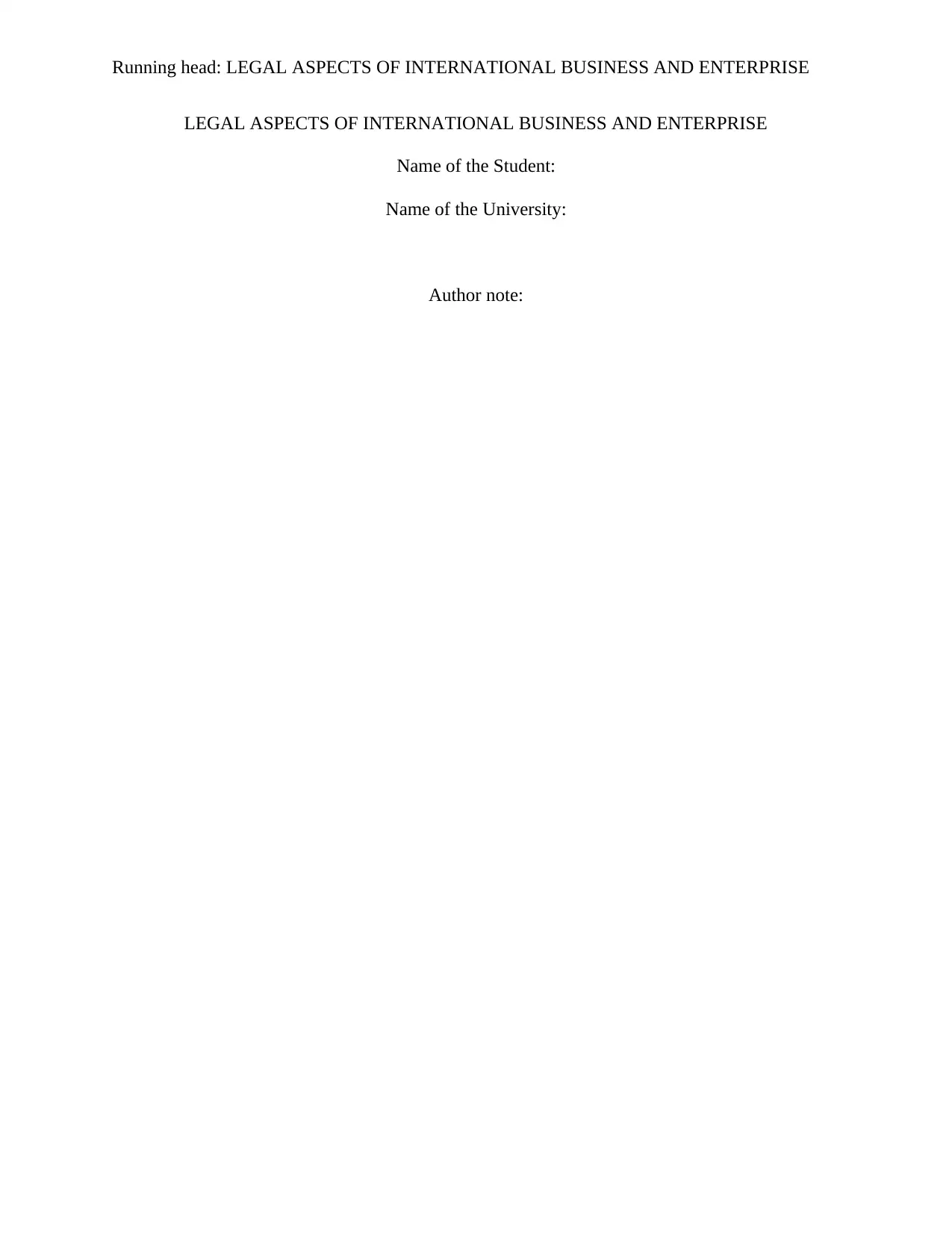
Running head: LEGAL ASPECTS OF INTERNATIONAL BUSINESS AND ENTERPRISE
LEGAL ASPECTS OF INTERNATIONAL BUSINESS AND ENTERPRISE
Name of the Student:
Name of the University:
Author note:
LEGAL ASPECTS OF INTERNATIONAL BUSINESS AND ENTERPRISE
Name of the Student:
Name of the University:
Author note:
Paraphrase This Document
Need a fresh take? Get an instant paraphrase of this document with our AI Paraphraser
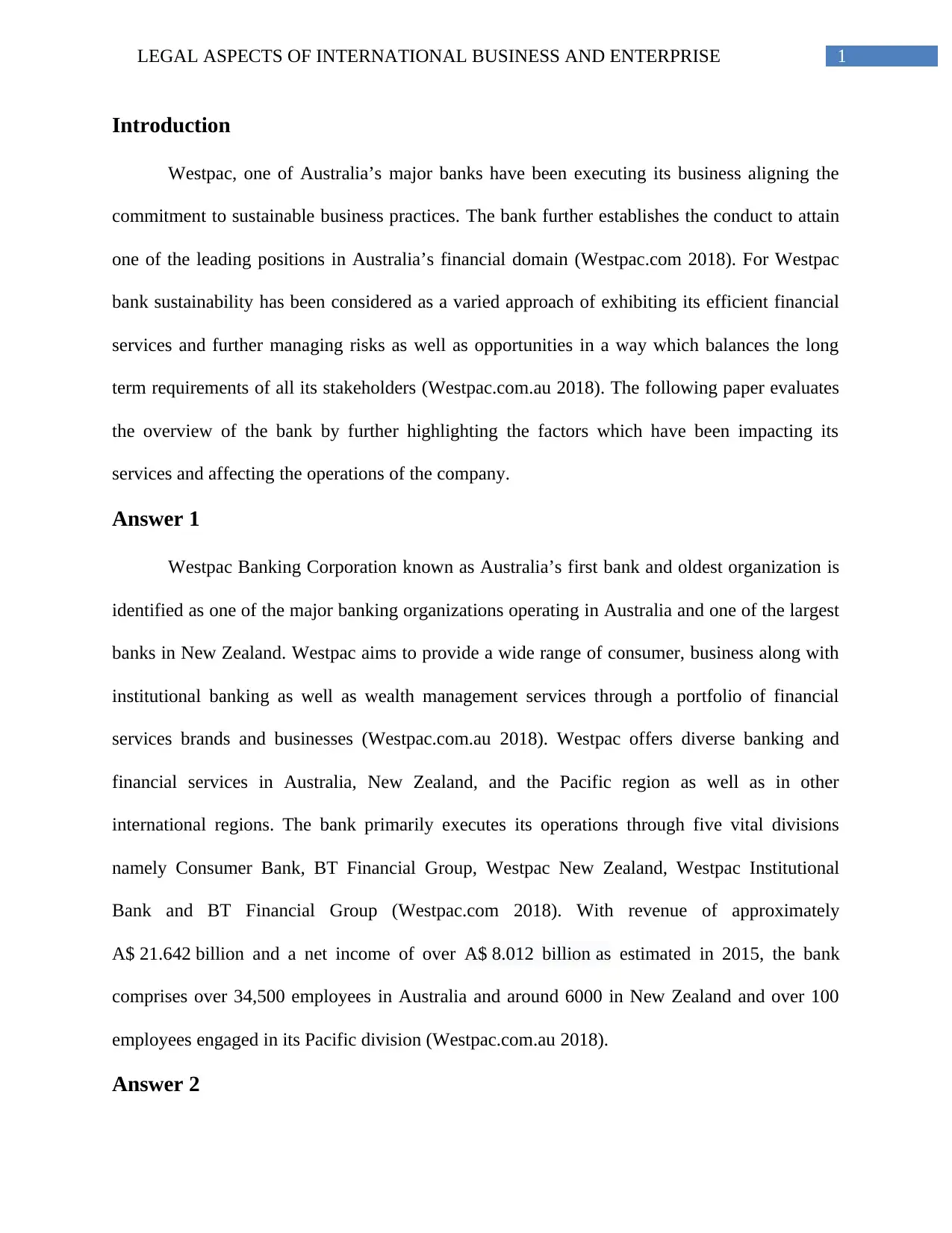
1LEGAL ASPECTS OF INTERNATIONAL BUSINESS AND ENTERPRISE
Introduction
Westpac, one of Australia’s major banks have been executing its business aligning the
commitment to sustainable business practices. The bank further establishes the conduct to attain
one of the leading positions in Australia’s financial domain (Westpac.com 2018). For Westpac
bank sustainability has been considered as a varied approach of exhibiting its efficient financial
services and further managing risks as well as opportunities in a way which balances the long
term requirements of all its stakeholders (Westpac.com.au 2018). The following paper evaluates
the overview of the bank by further highlighting the factors which have been impacting its
services and affecting the operations of the company.
Answer 1
Westpac Banking Corporation known as Australia’s first bank and oldest organization is
identified as one of the major banking organizations operating in Australia and one of the largest
banks in New Zealand. Westpac aims to provide a wide range of consumer, business along with
institutional banking as well as wealth management services through a portfolio of financial
services brands and businesses (Westpac.com.au 2018). Westpac offers diverse banking and
financial services in Australia, New Zealand, and the Pacific region as well as in other
international regions. The bank primarily executes its operations through five vital divisions
namely Consumer Bank, BT Financial Group, Westpac New Zealand, Westpac Institutional
Bank and BT Financial Group (Westpac.com 2018). With revenue of approximately
A$ 21.642 billion and a net income of over A$ 8.012 billion as estimated in 2015, the bank
comprises over 34,500 employees in Australia and around 6000 in New Zealand and over 100
employees engaged in its Pacific division (Westpac.com.au 2018).
Answer 2
Introduction
Westpac, one of Australia’s major banks have been executing its business aligning the
commitment to sustainable business practices. The bank further establishes the conduct to attain
one of the leading positions in Australia’s financial domain (Westpac.com 2018). For Westpac
bank sustainability has been considered as a varied approach of exhibiting its efficient financial
services and further managing risks as well as opportunities in a way which balances the long
term requirements of all its stakeholders (Westpac.com.au 2018). The following paper evaluates
the overview of the bank by further highlighting the factors which have been impacting its
services and affecting the operations of the company.
Answer 1
Westpac Banking Corporation known as Australia’s first bank and oldest organization is
identified as one of the major banking organizations operating in Australia and one of the largest
banks in New Zealand. Westpac aims to provide a wide range of consumer, business along with
institutional banking as well as wealth management services through a portfolio of financial
services brands and businesses (Westpac.com.au 2018). Westpac offers diverse banking and
financial services in Australia, New Zealand, and the Pacific region as well as in other
international regions. The bank primarily executes its operations through five vital divisions
namely Consumer Bank, BT Financial Group, Westpac New Zealand, Westpac Institutional
Bank and BT Financial Group (Westpac.com 2018). With revenue of approximately
A$ 21.642 billion and a net income of over A$ 8.012 billion as estimated in 2015, the bank
comprises over 34,500 employees in Australia and around 6000 in New Zealand and over 100
employees engaged in its Pacific division (Westpac.com.au 2018).
Answer 2
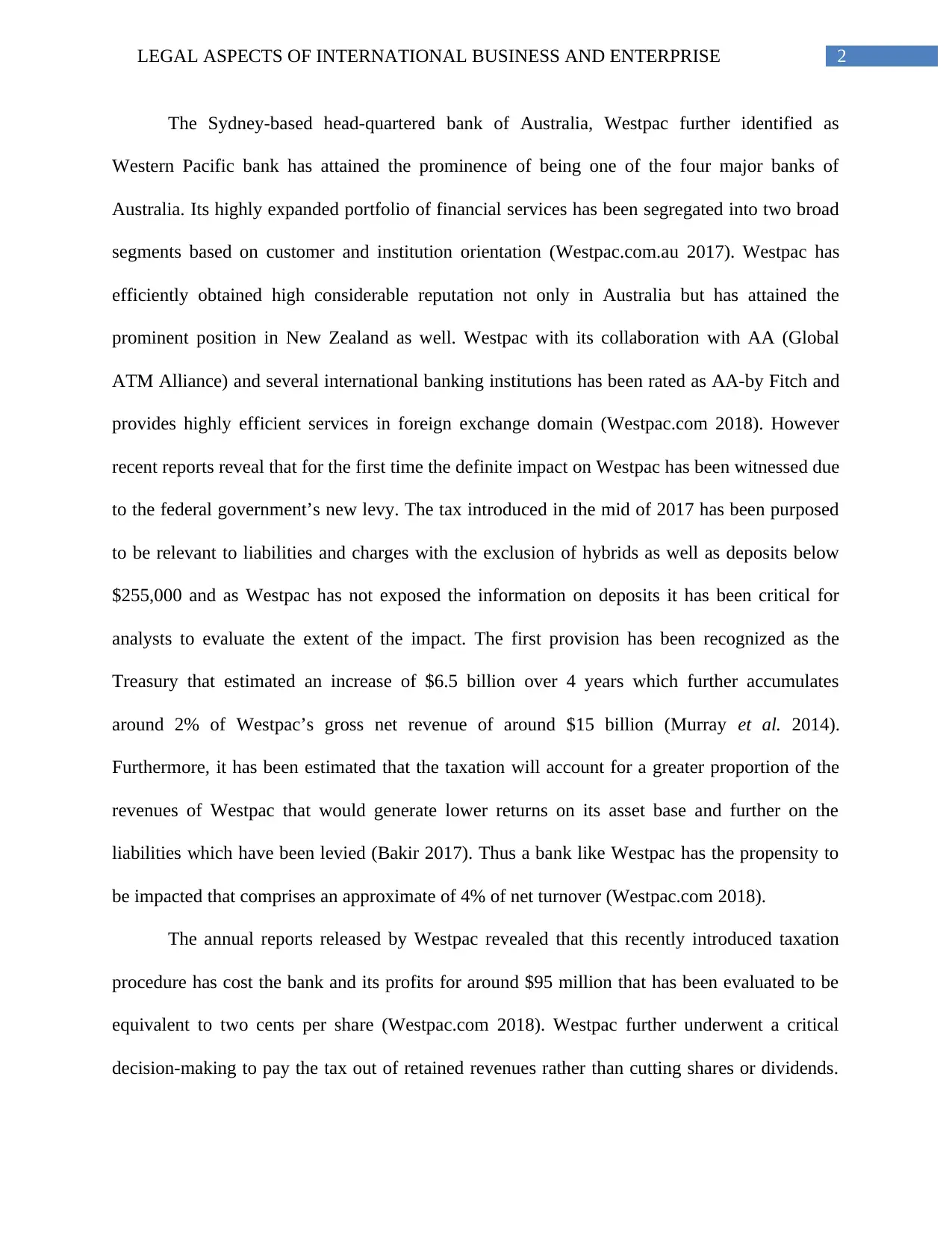
2LEGAL ASPECTS OF INTERNATIONAL BUSINESS AND ENTERPRISE
The Sydney-based head-quartered bank of Australia, Westpac further identified as
Western Pacific bank has attained the prominence of being one of the four major banks of
Australia. Its highly expanded portfolio of financial services has been segregated into two broad
segments based on customer and institution orientation (Westpac.com.au 2017). Westpac has
efficiently obtained high considerable reputation not only in Australia but has attained the
prominent position in New Zealand as well. Westpac with its collaboration with AA (Global
ATM Alliance) and several international banking institutions has been rated as AA-by Fitch and
provides highly efficient services in foreign exchange domain (Westpac.com 2018). However
recent reports reveal that for the first time the definite impact on Westpac has been witnessed due
to the federal government’s new levy. The tax introduced in the mid of 2017 has been purposed
to be relevant to liabilities and charges with the exclusion of hybrids as well as deposits below
$255,000 and as Westpac has not exposed the information on deposits it has been critical for
analysts to evaluate the extent of the impact. The first provision has been recognized as the
Treasury that estimated an increase of $6.5 billion over 4 years which further accumulates
around 2% of Westpac’s gross net revenue of around $15 billion (Murray et al. 2014).
Furthermore, it has been estimated that the taxation will account for a greater proportion of the
revenues of Westpac that would generate lower returns on its asset base and further on the
liabilities which have been levied (Bakir 2017). Thus a bank like Westpac has the propensity to
be impacted that comprises an approximate of 4% of net turnover (Westpac.com 2018).
The annual reports released by Westpac revealed that this recently introduced taxation
procedure has cost the bank and its profits for around $95 million that has been evaluated to be
equivalent to two cents per share (Westpac.com 2018). Westpac further underwent a critical
decision-making to pay the tax out of retained revenues rather than cutting shares or dividends.
The Sydney-based head-quartered bank of Australia, Westpac further identified as
Western Pacific bank has attained the prominence of being one of the four major banks of
Australia. Its highly expanded portfolio of financial services has been segregated into two broad
segments based on customer and institution orientation (Westpac.com.au 2017). Westpac has
efficiently obtained high considerable reputation not only in Australia but has attained the
prominent position in New Zealand as well. Westpac with its collaboration with AA (Global
ATM Alliance) and several international banking institutions has been rated as AA-by Fitch and
provides highly efficient services in foreign exchange domain (Westpac.com 2018). However
recent reports reveal that for the first time the definite impact on Westpac has been witnessed due
to the federal government’s new levy. The tax introduced in the mid of 2017 has been purposed
to be relevant to liabilities and charges with the exclusion of hybrids as well as deposits below
$255,000 and as Westpac has not exposed the information on deposits it has been critical for
analysts to evaluate the extent of the impact. The first provision has been recognized as the
Treasury that estimated an increase of $6.5 billion over 4 years which further accumulates
around 2% of Westpac’s gross net revenue of around $15 billion (Murray et al. 2014).
Furthermore, it has been estimated that the taxation will account for a greater proportion of the
revenues of Westpac that would generate lower returns on its asset base and further on the
liabilities which have been levied (Bakir 2017). Thus a bank like Westpac has the propensity to
be impacted that comprises an approximate of 4% of net turnover (Westpac.com 2018).
The annual reports released by Westpac revealed that this recently introduced taxation
procedure has cost the bank and its profits for around $95 million that has been evaluated to be
equivalent to two cents per share (Westpac.com 2018). Westpac further underwent a critical
decision-making to pay the tax out of retained revenues rather than cutting shares or dividends.
⊘ This is a preview!⊘
Do you want full access?
Subscribe today to unlock all pages.

Trusted by 1+ million students worldwide
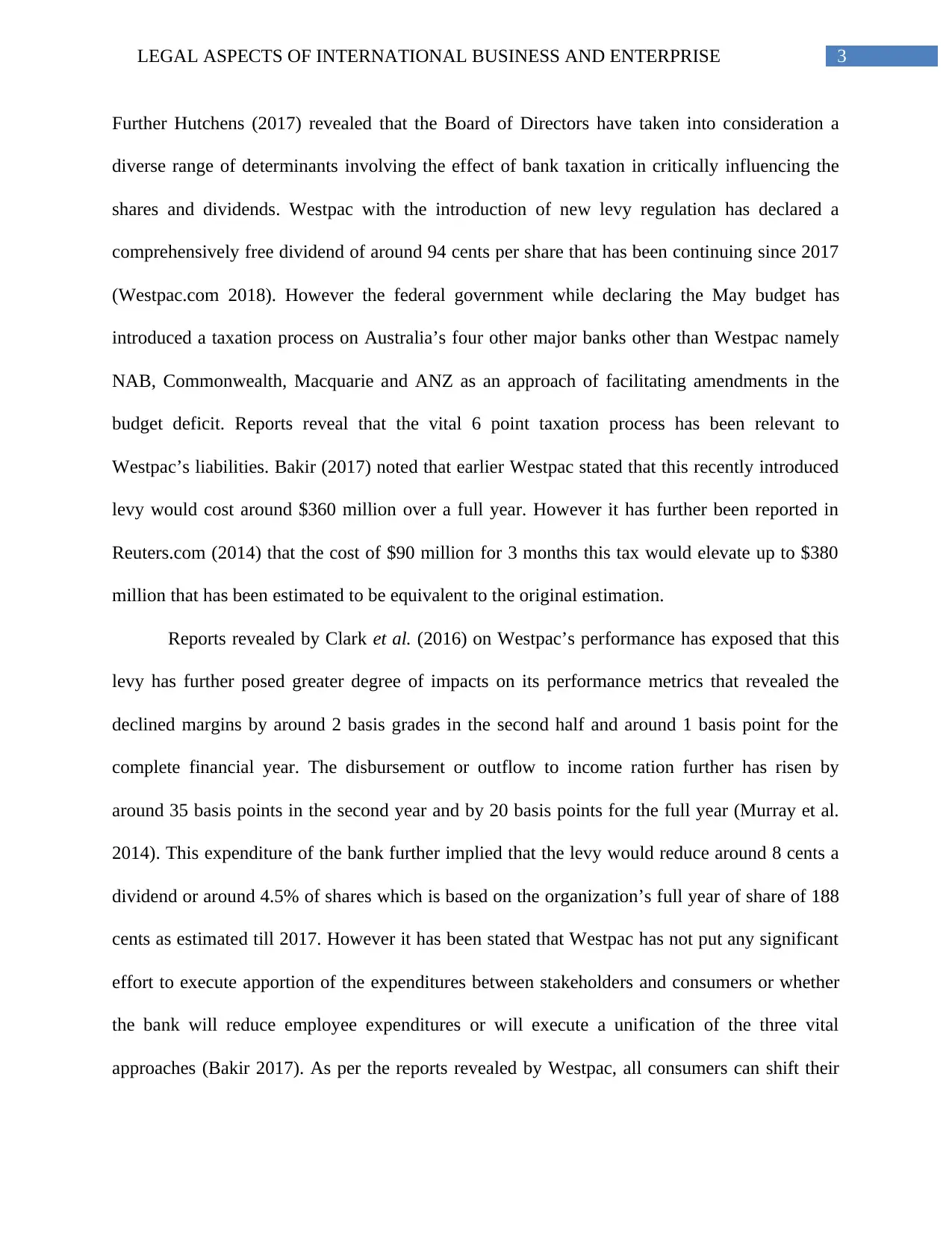
3LEGAL ASPECTS OF INTERNATIONAL BUSINESS AND ENTERPRISE
Further Hutchens (2017) revealed that the Board of Directors have taken into consideration a
diverse range of determinants involving the effect of bank taxation in critically influencing the
shares and dividends. Westpac with the introduction of new levy regulation has declared a
comprehensively free dividend of around 94 cents per share that has been continuing since 2017
(Westpac.com 2018). However the federal government while declaring the May budget has
introduced a taxation process on Australia’s four other major banks other than Westpac namely
NAB, Commonwealth, Macquarie and ANZ as an approach of facilitating amendments in the
budget deficit. Reports reveal that the vital 6 point taxation process has been relevant to
Westpac’s liabilities. Bakir (2017) noted that earlier Westpac stated that this recently introduced
levy would cost around $360 million over a full year. However it has further been reported in
Reuters.com (2014) that the cost of $90 million for 3 months this tax would elevate up to $380
million that has been estimated to be equivalent to the original estimation.
Reports revealed by Clark et al. (2016) on Westpac’s performance has exposed that this
levy has further posed greater degree of impacts on its performance metrics that revealed the
declined margins by around 2 basis grades in the second half and around 1 basis point for the
complete financial year. The disbursement or outflow to income ration further has risen by
around 35 basis points in the second year and by 20 basis points for the full year (Murray et al.
2014). This expenditure of the bank further implied that the levy would reduce around 8 cents a
dividend or around 4.5% of shares which is based on the organization’s full year of share of 188
cents as estimated till 2017. However it has been stated that Westpac has not put any significant
effort to execute apportion of the expenditures between stakeholders and consumers or whether
the bank will reduce employee expenditures or will execute a unification of the three vital
approaches (Bakir 2017). As per the reports revealed by Westpac, all consumers can shift their
Further Hutchens (2017) revealed that the Board of Directors have taken into consideration a
diverse range of determinants involving the effect of bank taxation in critically influencing the
shares and dividends. Westpac with the introduction of new levy regulation has declared a
comprehensively free dividend of around 94 cents per share that has been continuing since 2017
(Westpac.com 2018). However the federal government while declaring the May budget has
introduced a taxation process on Australia’s four other major banks other than Westpac namely
NAB, Commonwealth, Macquarie and ANZ as an approach of facilitating amendments in the
budget deficit. Reports reveal that the vital 6 point taxation process has been relevant to
Westpac’s liabilities. Bakir (2017) noted that earlier Westpac stated that this recently introduced
levy would cost around $360 million over a full year. However it has further been reported in
Reuters.com (2014) that the cost of $90 million for 3 months this tax would elevate up to $380
million that has been estimated to be equivalent to the original estimation.
Reports revealed by Clark et al. (2016) on Westpac’s performance has exposed that this
levy has further posed greater degree of impacts on its performance metrics that revealed the
declined margins by around 2 basis grades in the second half and around 1 basis point for the
complete financial year. The disbursement or outflow to income ration further has risen by
around 35 basis points in the second year and by 20 basis points for the full year (Murray et al.
2014). This expenditure of the bank further implied that the levy would reduce around 8 cents a
dividend or around 4.5% of shares which is based on the organization’s full year of share of 188
cents as estimated till 2017. However it has been stated that Westpac has not put any significant
effort to execute apportion of the expenditures between stakeholders and consumers or whether
the bank will reduce employee expenditures or will execute a unification of the three vital
approaches (Bakir 2017). As per the reports revealed by Westpac, all consumers can shift their
Paraphrase This Document
Need a fresh take? Get an instant paraphrase of this document with our AI Paraphraser
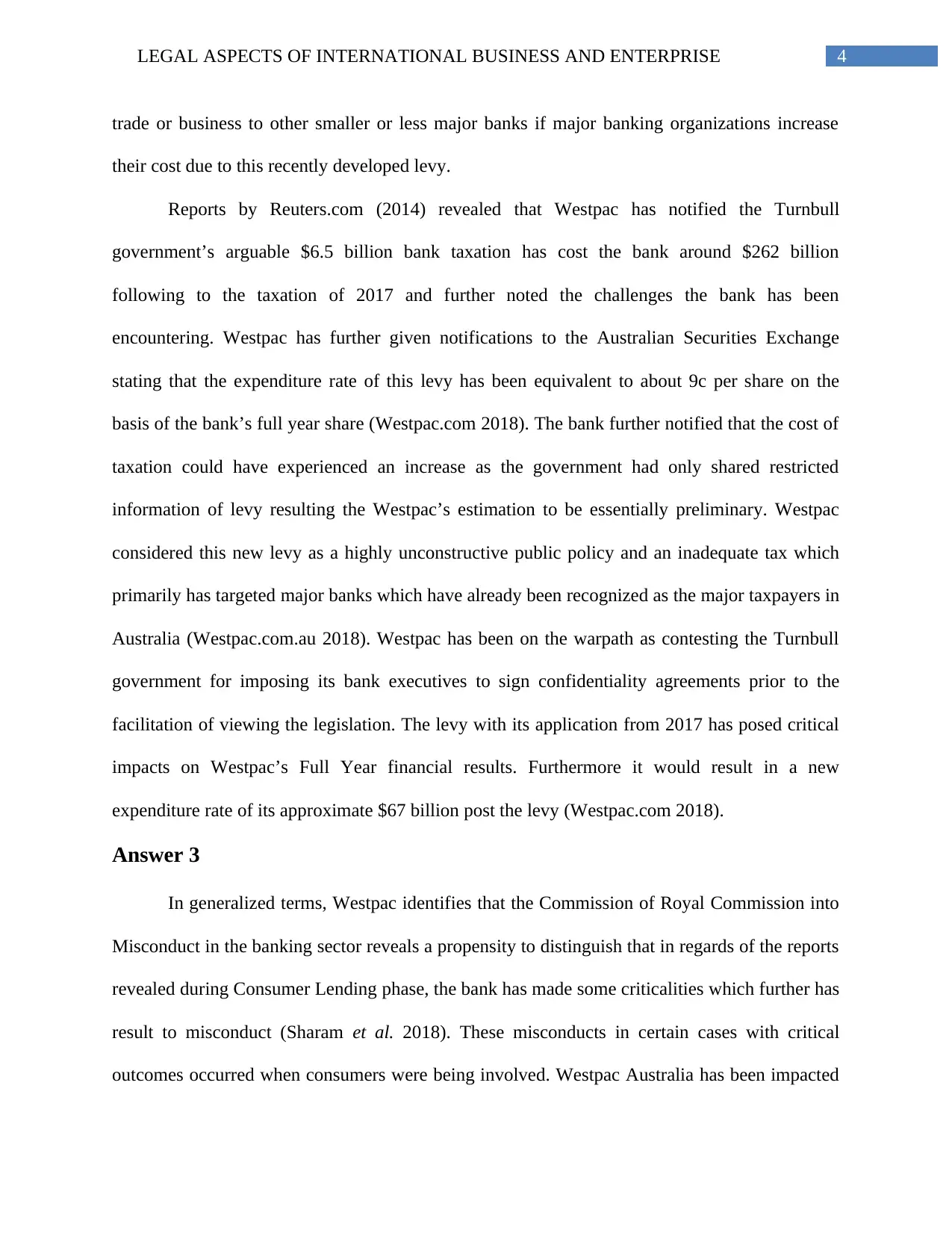
4LEGAL ASPECTS OF INTERNATIONAL BUSINESS AND ENTERPRISE
trade or business to other smaller or less major banks if major banking organizations increase
their cost due to this recently developed levy.
Reports by Reuters.com (2014) revealed that Westpac has notified the Turnbull
government’s arguable $6.5 billion bank taxation has cost the bank around $262 billion
following to the taxation of 2017 and further noted the challenges the bank has been
encountering. Westpac has further given notifications to the Australian Securities Exchange
stating that the expenditure rate of this levy has been equivalent to about 9c per share on the
basis of the bank’s full year share (Westpac.com 2018). The bank further notified that the cost of
taxation could have experienced an increase as the government had only shared restricted
information of levy resulting the Westpac’s estimation to be essentially preliminary. Westpac
considered this new levy as a highly unconstructive public policy and an inadequate tax which
primarily has targeted major banks which have already been recognized as the major taxpayers in
Australia (Westpac.com.au 2018). Westpac has been on the warpath as contesting the Turnbull
government for imposing its bank executives to sign confidentiality agreements prior to the
facilitation of viewing the legislation. The levy with its application from 2017 has posed critical
impacts on Westpac’s Full Year financial results. Furthermore it would result in a new
expenditure rate of its approximate $67 billion post the levy (Westpac.com 2018).
Answer 3
In generalized terms, Westpac identifies that the Commission of Royal Commission into
Misconduct in the banking sector reveals a propensity to distinguish that in regards of the reports
revealed during Consumer Lending phase, the bank has made some criticalities which further has
result to misconduct (Sharam et al. 2018). These misconducts in certain cases with critical
outcomes occurred when consumers were being involved. Westpac Australia has been impacted
trade or business to other smaller or less major banks if major banking organizations increase
their cost due to this recently developed levy.
Reports by Reuters.com (2014) revealed that Westpac has notified the Turnbull
government’s arguable $6.5 billion bank taxation has cost the bank around $262 billion
following to the taxation of 2017 and further noted the challenges the bank has been
encountering. Westpac has further given notifications to the Australian Securities Exchange
stating that the expenditure rate of this levy has been equivalent to about 9c per share on the
basis of the bank’s full year share (Westpac.com 2018). The bank further notified that the cost of
taxation could have experienced an increase as the government had only shared restricted
information of levy resulting the Westpac’s estimation to be essentially preliminary. Westpac
considered this new levy as a highly unconstructive public policy and an inadequate tax which
primarily has targeted major banks which have already been recognized as the major taxpayers in
Australia (Westpac.com.au 2018). Westpac has been on the warpath as contesting the Turnbull
government for imposing its bank executives to sign confidentiality agreements prior to the
facilitation of viewing the legislation. The levy with its application from 2017 has posed critical
impacts on Westpac’s Full Year financial results. Furthermore it would result in a new
expenditure rate of its approximate $67 billion post the levy (Westpac.com 2018).
Answer 3
In generalized terms, Westpac identifies that the Commission of Royal Commission into
Misconduct in the banking sector reveals a propensity to distinguish that in regards of the reports
revealed during Consumer Lending phase, the bank has made some criticalities which further has
result to misconduct (Sharam et al. 2018). These misconducts in certain cases with critical
outcomes occurred when consumers were being involved. Westpac Australia has been impacted
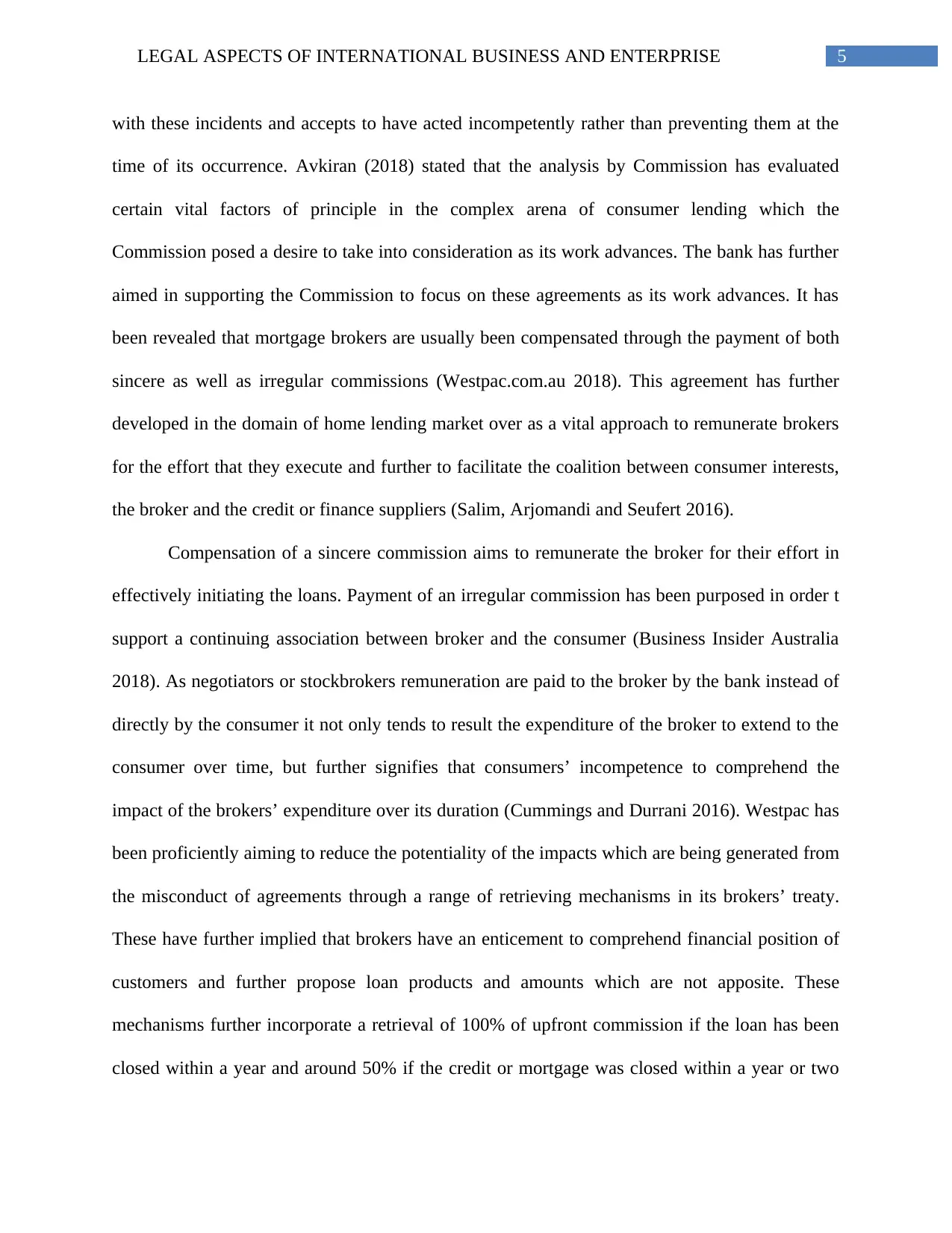
5LEGAL ASPECTS OF INTERNATIONAL BUSINESS AND ENTERPRISE
with these incidents and accepts to have acted incompetently rather than preventing them at the
time of its occurrence. Avkiran (2018) stated that the analysis by Commission has evaluated
certain vital factors of principle in the complex arena of consumer lending which the
Commission posed a desire to take into consideration as its work advances. The bank has further
aimed in supporting the Commission to focus on these agreements as its work advances. It has
been revealed that mortgage brokers are usually been compensated through the payment of both
sincere as well as irregular commissions (Westpac.com.au 2018). This agreement has further
developed in the domain of home lending market over as a vital approach to remunerate brokers
for the effort that they execute and further to facilitate the coalition between consumer interests,
the broker and the credit or finance suppliers (Salim, Arjomandi and Seufert 2016).
Compensation of a sincere commission aims to remunerate the broker for their effort in
effectively initiating the loans. Payment of an irregular commission has been purposed in order t
support a continuing association between broker and the consumer (Business Insider Australia
2018). As negotiators or stockbrokers remuneration are paid to the broker by the bank instead of
directly by the consumer it not only tends to result the expenditure of the broker to extend to the
consumer over time, but further signifies that consumers’ incompetence to comprehend the
impact of the brokers’ expenditure over its duration (Cummings and Durrani 2016). Westpac has
been proficiently aiming to reduce the potentiality of the impacts which are being generated from
the misconduct of agreements through a range of retrieving mechanisms in its brokers’ treaty.
These have further implied that brokers have an enticement to comprehend financial position of
customers and further propose loan products and amounts which are not apposite. These
mechanisms further incorporate a retrieval of 100% of upfront commission if the loan has been
closed within a year and around 50% if the credit or mortgage was closed within a year or two
with these incidents and accepts to have acted incompetently rather than preventing them at the
time of its occurrence. Avkiran (2018) stated that the analysis by Commission has evaluated
certain vital factors of principle in the complex arena of consumer lending which the
Commission posed a desire to take into consideration as its work advances. The bank has further
aimed in supporting the Commission to focus on these agreements as its work advances. It has
been revealed that mortgage brokers are usually been compensated through the payment of both
sincere as well as irregular commissions (Westpac.com.au 2018). This agreement has further
developed in the domain of home lending market over as a vital approach to remunerate brokers
for the effort that they execute and further to facilitate the coalition between consumer interests,
the broker and the credit or finance suppliers (Salim, Arjomandi and Seufert 2016).
Compensation of a sincere commission aims to remunerate the broker for their effort in
effectively initiating the loans. Payment of an irregular commission has been purposed in order t
support a continuing association between broker and the consumer (Business Insider Australia
2018). As negotiators or stockbrokers remuneration are paid to the broker by the bank instead of
directly by the consumer it not only tends to result the expenditure of the broker to extend to the
consumer over time, but further signifies that consumers’ incompetence to comprehend the
impact of the brokers’ expenditure over its duration (Cummings and Durrani 2016). Westpac has
been proficiently aiming to reduce the potentiality of the impacts which are being generated from
the misconduct of agreements through a range of retrieving mechanisms in its brokers’ treaty.
These have further implied that brokers have an enticement to comprehend financial position of
customers and further propose loan products and amounts which are not apposite. These
mechanisms further incorporate a retrieval of 100% of upfront commission if the loan has been
closed within a year and around 50% if the credit or mortgage was closed within a year or two
⊘ This is a preview!⊘
Do you want full access?
Subscribe today to unlock all pages.

Trusted by 1+ million students worldwide
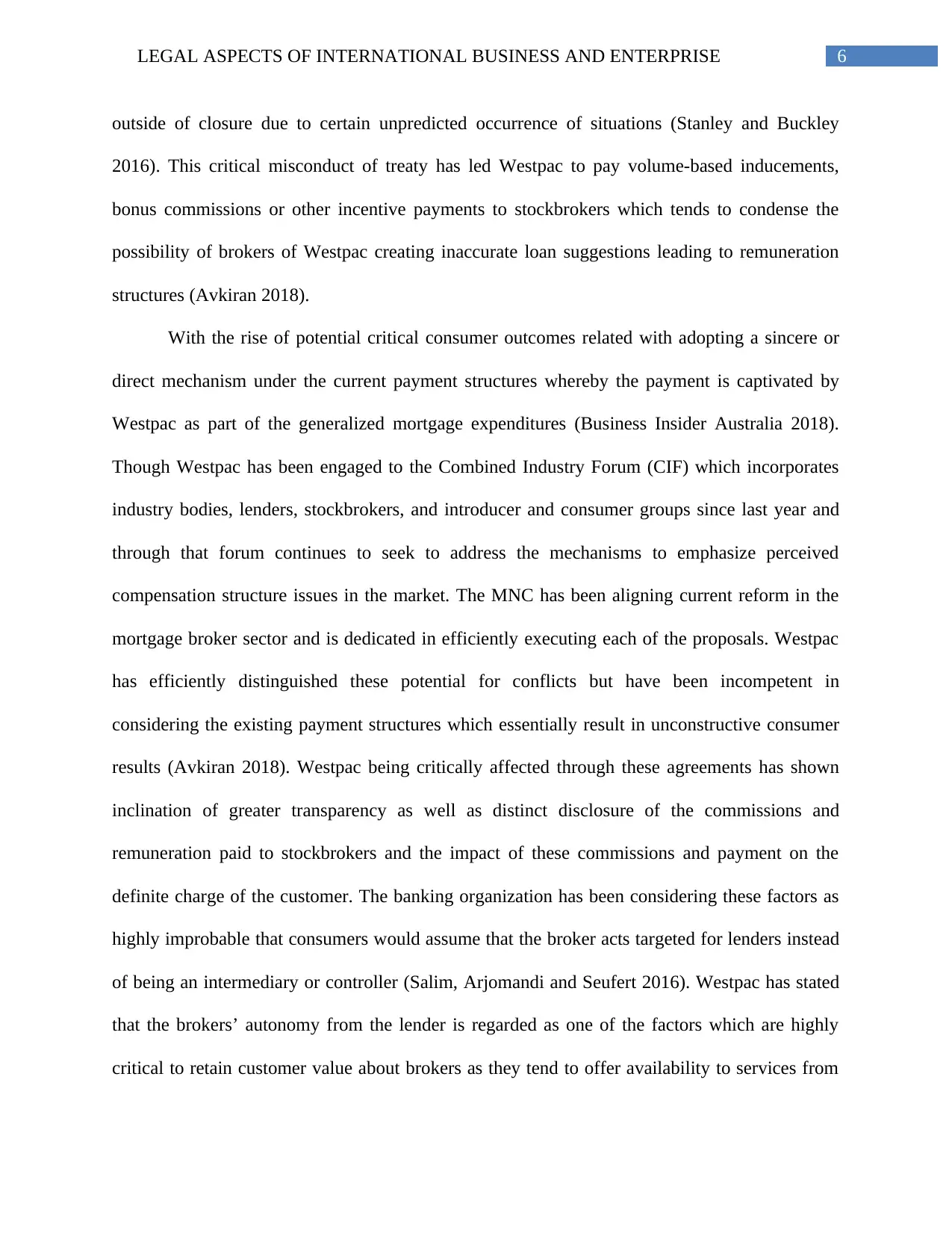
6LEGAL ASPECTS OF INTERNATIONAL BUSINESS AND ENTERPRISE
outside of closure due to certain unpredicted occurrence of situations (Stanley and Buckley
2016). This critical misconduct of treaty has led Westpac to pay volume-based inducements,
bonus commissions or other incentive payments to stockbrokers which tends to condense the
possibility of brokers of Westpac creating inaccurate loan suggestions leading to remuneration
structures (Avkiran 2018).
With the rise of potential critical consumer outcomes related with adopting a sincere or
direct mechanism under the current payment structures whereby the payment is captivated by
Westpac as part of the generalized mortgage expenditures (Business Insider Australia 2018).
Though Westpac has been engaged to the Combined Industry Forum (CIF) which incorporates
industry bodies, lenders, stockbrokers, and introducer and consumer groups since last year and
through that forum continues to seek to address the mechanisms to emphasize perceived
compensation structure issues in the market. The MNC has been aligning current reform in the
mortgage broker sector and is dedicated in efficiently executing each of the proposals. Westpac
has efficiently distinguished these potential for conflicts but have been incompetent in
considering the existing payment structures which essentially result in unconstructive consumer
results (Avkiran 2018). Westpac being critically affected through these agreements has shown
inclination of greater transparency as well as distinct disclosure of the commissions and
remuneration paid to stockbrokers and the impact of these commissions and payment on the
definite charge of the customer. The banking organization has been considering these factors as
highly improbable that consumers would assume that the broker acts targeted for lenders instead
of being an intermediary or controller (Salim, Arjomandi and Seufert 2016). Westpac has stated
that the brokers’ autonomy from the lender is regarded as one of the factors which are highly
critical to retain customer value about brokers as they tend to offer availability to services from
outside of closure due to certain unpredicted occurrence of situations (Stanley and Buckley
2016). This critical misconduct of treaty has led Westpac to pay volume-based inducements,
bonus commissions or other incentive payments to stockbrokers which tends to condense the
possibility of brokers of Westpac creating inaccurate loan suggestions leading to remuneration
structures (Avkiran 2018).
With the rise of potential critical consumer outcomes related with adopting a sincere or
direct mechanism under the current payment structures whereby the payment is captivated by
Westpac as part of the generalized mortgage expenditures (Business Insider Australia 2018).
Though Westpac has been engaged to the Combined Industry Forum (CIF) which incorporates
industry bodies, lenders, stockbrokers, and introducer and consumer groups since last year and
through that forum continues to seek to address the mechanisms to emphasize perceived
compensation structure issues in the market. The MNC has been aligning current reform in the
mortgage broker sector and is dedicated in efficiently executing each of the proposals. Westpac
has efficiently distinguished these potential for conflicts but have been incompetent in
considering the existing payment structures which essentially result in unconstructive consumer
results (Avkiran 2018). Westpac being critically affected through these agreements has shown
inclination of greater transparency as well as distinct disclosure of the commissions and
remuneration paid to stockbrokers and the impact of these commissions and payment on the
definite charge of the customer. The banking organization has been considering these factors as
highly improbable that consumers would assume that the broker acts targeted for lenders instead
of being an intermediary or controller (Salim, Arjomandi and Seufert 2016). Westpac has stated
that the brokers’ autonomy from the lender is regarded as one of the factors which are highly
critical to retain customer value about brokers as they tend to offer availability to services from
Paraphrase This Document
Need a fresh take? Get an instant paraphrase of this document with our AI Paraphraser
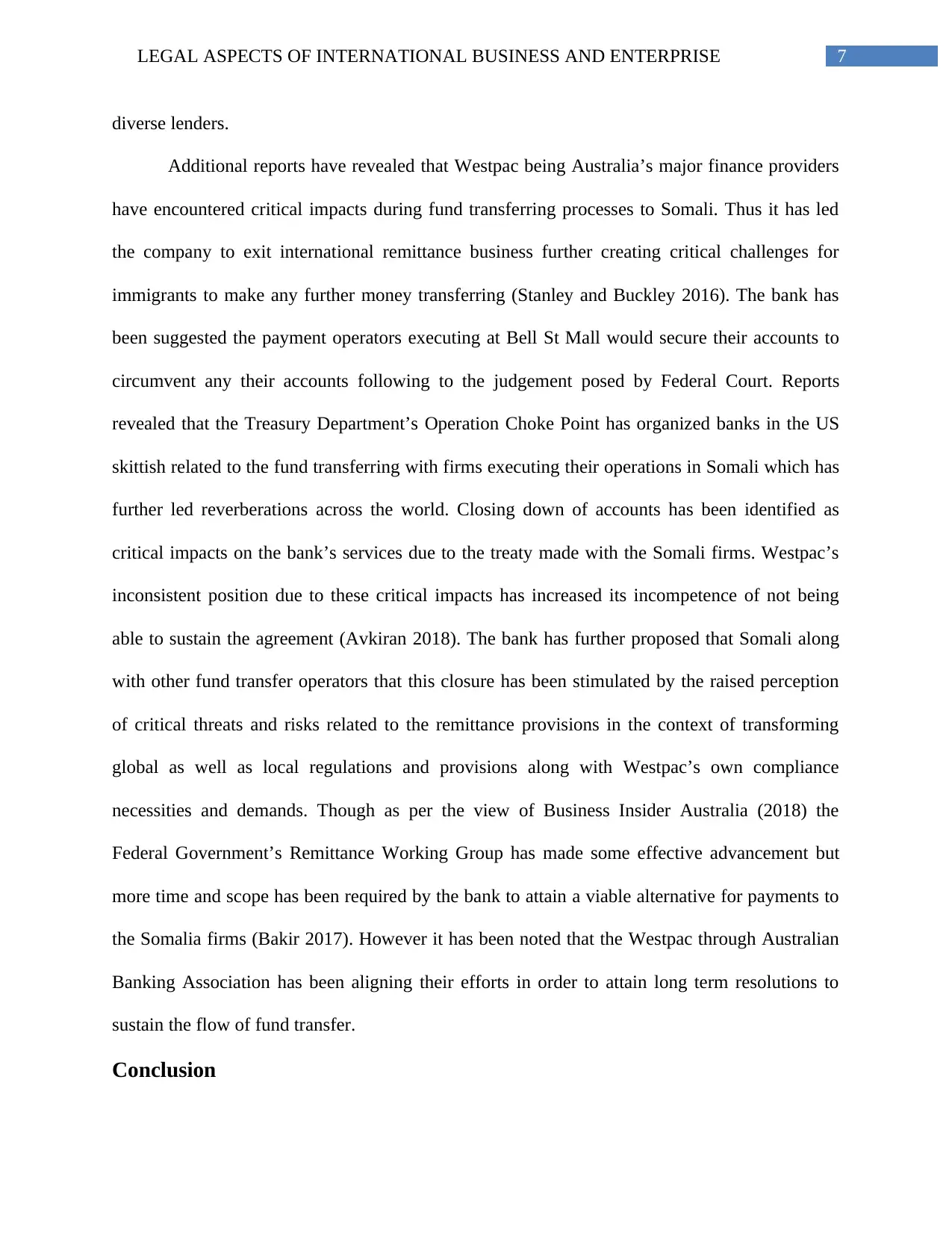
7LEGAL ASPECTS OF INTERNATIONAL BUSINESS AND ENTERPRISE
diverse lenders.
Additional reports have revealed that Westpac being Australia’s major finance providers
have encountered critical impacts during fund transferring processes to Somali. Thus it has led
the company to exit international remittance business further creating critical challenges for
immigrants to make any further money transferring (Stanley and Buckley 2016). The bank has
been suggested the payment operators executing at Bell St Mall would secure their accounts to
circumvent any their accounts following to the judgement posed by Federal Court. Reports
revealed that the Treasury Department’s Operation Choke Point has organized banks in the US
skittish related to the fund transferring with firms executing their operations in Somali which has
further led reverberations across the world. Closing down of accounts has been identified as
critical impacts on the bank’s services due to the treaty made with the Somali firms. Westpac’s
inconsistent position due to these critical impacts has increased its incompetence of not being
able to sustain the agreement (Avkiran 2018). The bank has further proposed that Somali along
with other fund transfer operators that this closure has been stimulated by the raised perception
of critical threats and risks related to the remittance provisions in the context of transforming
global as well as local regulations and provisions along with Westpac’s own compliance
necessities and demands. Though as per the view of Business Insider Australia (2018) the
Federal Government’s Remittance Working Group has made some effective advancement but
more time and scope has been required by the bank to attain a viable alternative for payments to
the Somalia firms (Bakir 2017). However it has been noted that the Westpac through Australian
Banking Association has been aligning their efforts in order to attain long term resolutions to
sustain the flow of fund transfer.
Conclusion
diverse lenders.
Additional reports have revealed that Westpac being Australia’s major finance providers
have encountered critical impacts during fund transferring processes to Somali. Thus it has led
the company to exit international remittance business further creating critical challenges for
immigrants to make any further money transferring (Stanley and Buckley 2016). The bank has
been suggested the payment operators executing at Bell St Mall would secure their accounts to
circumvent any their accounts following to the judgement posed by Federal Court. Reports
revealed that the Treasury Department’s Operation Choke Point has organized banks in the US
skittish related to the fund transferring with firms executing their operations in Somali which has
further led reverberations across the world. Closing down of accounts has been identified as
critical impacts on the bank’s services due to the treaty made with the Somali firms. Westpac’s
inconsistent position due to these critical impacts has increased its incompetence of not being
able to sustain the agreement (Avkiran 2018). The bank has further proposed that Somali along
with other fund transfer operators that this closure has been stimulated by the raised perception
of critical threats and risks related to the remittance provisions in the context of transforming
global as well as local regulations and provisions along with Westpac’s own compliance
necessities and demands. Though as per the view of Business Insider Australia (2018) the
Federal Government’s Remittance Working Group has made some effective advancement but
more time and scope has been required by the bank to attain a viable alternative for payments to
the Somalia firms (Bakir 2017). However it has been noted that the Westpac through Australian
Banking Association has been aligning their efforts in order to attain long term resolutions to
sustain the flow of fund transfer.
Conclusion
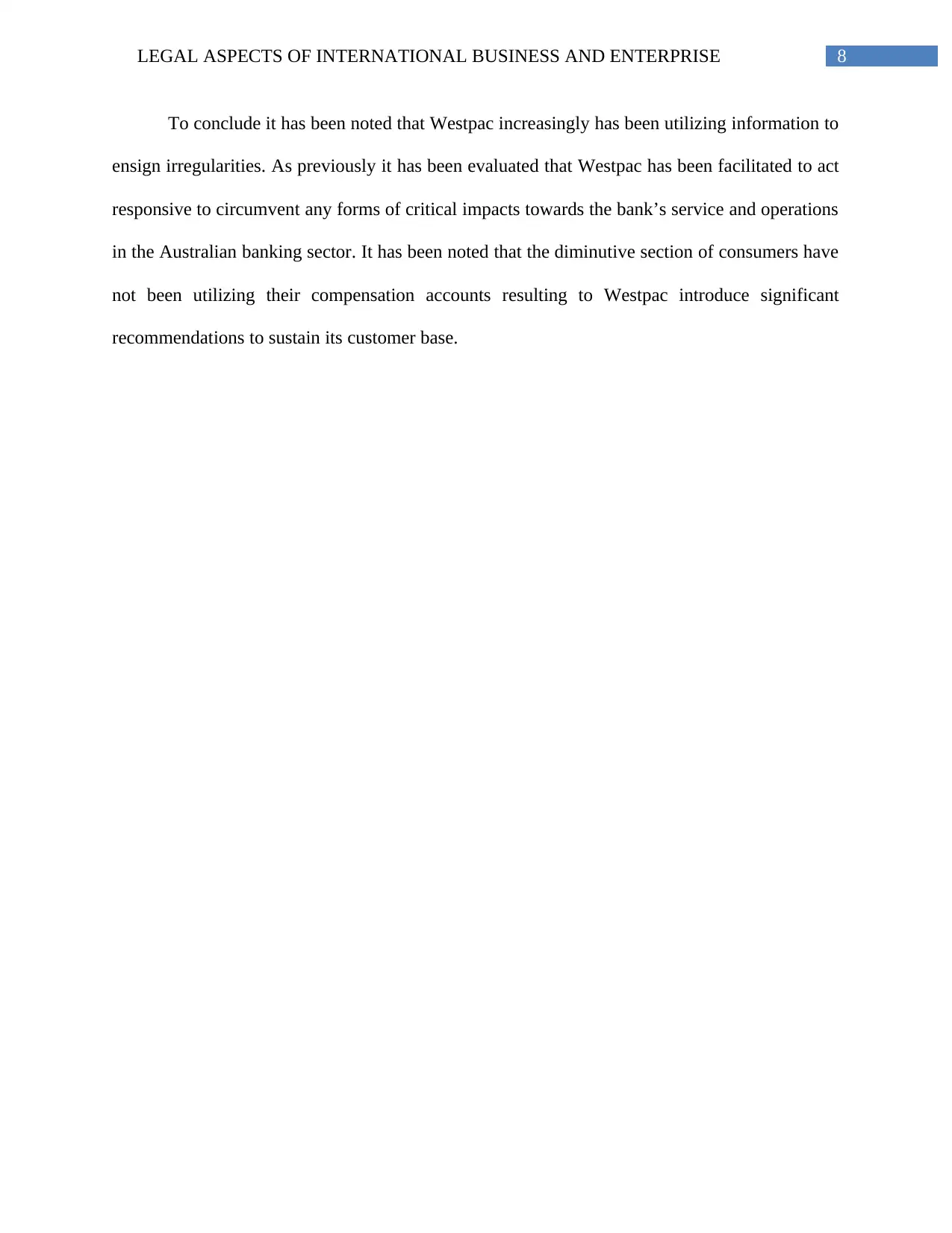
8LEGAL ASPECTS OF INTERNATIONAL BUSINESS AND ENTERPRISE
To conclude it has been noted that Westpac increasingly has been utilizing information to
ensign irregularities. As previously it has been evaluated that Westpac has been facilitated to act
responsive to circumvent any forms of critical impacts towards the bank’s service and operations
in the Australian banking sector. It has been noted that the diminutive section of consumers have
not been utilizing their compensation accounts resulting to Westpac introduce significant
recommendations to sustain its customer base.
To conclude it has been noted that Westpac increasingly has been utilizing information to
ensign irregularities. As previously it has been evaluated that Westpac has been facilitated to act
responsive to circumvent any forms of critical impacts towards the bank’s service and operations
in the Australian banking sector. It has been noted that the diminutive section of consumers have
not been utilizing their compensation accounts resulting to Westpac introduce significant
recommendations to sustain its customer base.
⊘ This is a preview!⊘
Do you want full access?
Subscribe today to unlock all pages.

Trusted by 1+ million students worldwide
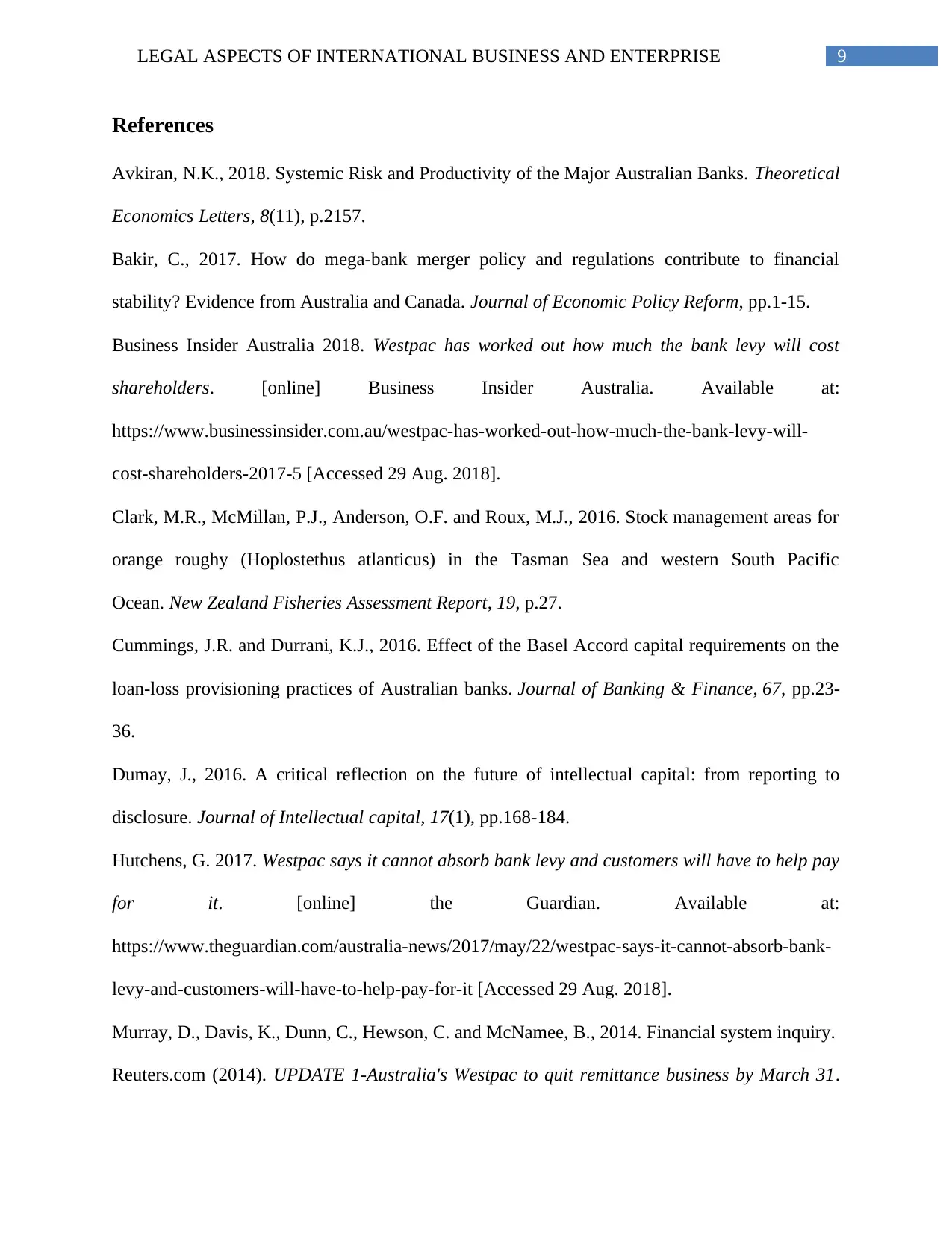
9LEGAL ASPECTS OF INTERNATIONAL BUSINESS AND ENTERPRISE
References
Avkiran, N.K., 2018. Systemic Risk and Productivity of the Major Australian Banks. Theoretical
Economics Letters, 8(11), p.2157.
Bakir, C., 2017. How do mega-bank merger policy and regulations contribute to financial
stability? Evidence from Australia and Canada. Journal of Economic Policy Reform, pp.1-15.
Business Insider Australia 2018. Westpac has worked out how much the bank levy will cost
shareholders. [online] Business Insider Australia. Available at:
https://www.businessinsider.com.au/westpac-has-worked-out-how-much-the-bank-levy-will-
cost-shareholders-2017-5 [Accessed 29 Aug. 2018].
Clark, M.R., McMillan, P.J., Anderson, O.F. and Roux, M.J., 2016. Stock management areas for
orange roughy (Hoplostethus atlanticus) in the Tasman Sea and western South Pacific
Ocean. New Zealand Fisheries Assessment Report, 19, p.27.
Cummings, J.R. and Durrani, K.J., 2016. Effect of the Basel Accord capital requirements on the
loan-loss provisioning practices of Australian banks. Journal of Banking & Finance, 67, pp.23-
36.
Dumay, J., 2016. A critical reflection on the future of intellectual capital: from reporting to
disclosure. Journal of Intellectual capital, 17(1), pp.168-184.
Hutchens, G. 2017. Westpac says it cannot absorb bank levy and customers will have to help pay
for it. [online] the Guardian. Available at:
https://www.theguardian.com/australia-news/2017/may/22/westpac-says-it-cannot-absorb-bank-
levy-and-customers-will-have-to-help-pay-for-it [Accessed 29 Aug. 2018].
Murray, D., Davis, K., Dunn, C., Hewson, C. and McNamee, B., 2014. Financial system inquiry.
Reuters.com (2014). UPDATE 1-Australia's Westpac to quit remittance business by March 31.
References
Avkiran, N.K., 2018. Systemic Risk and Productivity of the Major Australian Banks. Theoretical
Economics Letters, 8(11), p.2157.
Bakir, C., 2017. How do mega-bank merger policy and regulations contribute to financial
stability? Evidence from Australia and Canada. Journal of Economic Policy Reform, pp.1-15.
Business Insider Australia 2018. Westpac has worked out how much the bank levy will cost
shareholders. [online] Business Insider Australia. Available at:
https://www.businessinsider.com.au/westpac-has-worked-out-how-much-the-bank-levy-will-
cost-shareholders-2017-5 [Accessed 29 Aug. 2018].
Clark, M.R., McMillan, P.J., Anderson, O.F. and Roux, M.J., 2016. Stock management areas for
orange roughy (Hoplostethus atlanticus) in the Tasman Sea and western South Pacific
Ocean. New Zealand Fisheries Assessment Report, 19, p.27.
Cummings, J.R. and Durrani, K.J., 2016. Effect of the Basel Accord capital requirements on the
loan-loss provisioning practices of Australian banks. Journal of Banking & Finance, 67, pp.23-
36.
Dumay, J., 2016. A critical reflection on the future of intellectual capital: from reporting to
disclosure. Journal of Intellectual capital, 17(1), pp.168-184.
Hutchens, G. 2017. Westpac says it cannot absorb bank levy and customers will have to help pay
for it. [online] the Guardian. Available at:
https://www.theguardian.com/australia-news/2017/may/22/westpac-says-it-cannot-absorb-bank-
levy-and-customers-will-have-to-help-pay-for-it [Accessed 29 Aug. 2018].
Murray, D., Davis, K., Dunn, C., Hewson, C. and McNamee, B., 2014. Financial system inquiry.
Reuters.com (2014). UPDATE 1-Australia's Westpac to quit remittance business by March 31.
Paraphrase This Document
Need a fresh take? Get an instant paraphrase of this document with our AI Paraphraser

10LEGAL ASPECTS OF INTERNATIONAL BUSINESS AND ENTERPRISE
[online] U.S. Available at: https://www.reuters.com/article/australia-remittances-westpac/update-
1-australias-westpac-to-quit-remittance-business-by-march-31-idUSL3N0U61NF20141222
[Accessed 29 Aug. 2018].
Salim, R., Arjomandi, A. and Seufert, J.H., 2016. Does corporate governance affect Australian
banks' performance?. Journal of International Financial Markets, Institutions and Money, 43,
pp.113-125.
Sharam, A., Moran, M., Mason, C., Stone, W. and Findlay, S., 2018. Understanding
opportunities for social impact investment in the development of affordable housing.
Stanley, R.L. and Buckley, R.P., 2016. Protecting the west, excluding the rest: The impact of the
AML/CTF regime on financial inclusion in the pacific and potential responses. Melb. J. Int'l
L., 17, p.83.
Westpac.com.au 2017. New bank tax hits all Australians | Westpac. [online] Westpac.com.au.
Available at: https://www.westpac.com.au/about-westpac/media/media-releases/2017/10-may/
[Accessed 29 Aug. 2018].
Westpac.com.au 2018. Approach to tax | Westpac. [online] Westpac.com.au. Available at:
https://www.westpac.com.au/about-westpac/sustainability/our-positions-and-perspectives/
approach-to-tax/ [Accessed 29 Aug. 2018].
Westpac.com.au 2018. Corporate and institutional banking | Westpac. [online] Westpac.com.au.
Available at: https://www.westpac.com.au/corporate-banking/corporate-institutional/ [Accessed
29 Aug. 2018].
Westpac.com.au 2018. Westpac Group | Westpac. [online] Westpac.com.au. Available at:
https://www.westpac.com.au/about-westpac/westpac-group/ [Accessed 29 Aug. 2018].
[online] U.S. Available at: https://www.reuters.com/article/australia-remittances-westpac/update-
1-australias-westpac-to-quit-remittance-business-by-march-31-idUSL3N0U61NF20141222
[Accessed 29 Aug. 2018].
Salim, R., Arjomandi, A. and Seufert, J.H., 2016. Does corporate governance affect Australian
banks' performance?. Journal of International Financial Markets, Institutions and Money, 43,
pp.113-125.
Sharam, A., Moran, M., Mason, C., Stone, W. and Findlay, S., 2018. Understanding
opportunities for social impact investment in the development of affordable housing.
Stanley, R.L. and Buckley, R.P., 2016. Protecting the west, excluding the rest: The impact of the
AML/CTF regime on financial inclusion in the pacific and potential responses. Melb. J. Int'l
L., 17, p.83.
Westpac.com.au 2017. New bank tax hits all Australians | Westpac. [online] Westpac.com.au.
Available at: https://www.westpac.com.au/about-westpac/media/media-releases/2017/10-may/
[Accessed 29 Aug. 2018].
Westpac.com.au 2018. Approach to tax | Westpac. [online] Westpac.com.au. Available at:
https://www.westpac.com.au/about-westpac/sustainability/our-positions-and-perspectives/
approach-to-tax/ [Accessed 29 Aug. 2018].
Westpac.com.au 2018. Corporate and institutional banking | Westpac. [online] Westpac.com.au.
Available at: https://www.westpac.com.au/corporate-banking/corporate-institutional/ [Accessed
29 Aug. 2018].
Westpac.com.au 2018. Westpac Group | Westpac. [online] Westpac.com.au. Available at:
https://www.westpac.com.au/about-westpac/westpac-group/ [Accessed 29 Aug. 2018].
1 out of 11
Related Documents
Your All-in-One AI-Powered Toolkit for Academic Success.
+13062052269
info@desklib.com
Available 24*7 on WhatsApp / Email
![[object Object]](/_next/static/media/star-bottom.7253800d.svg)
Unlock your academic potential
Copyright © 2020–2025 A2Z Services. All Rights Reserved. Developed and managed by ZUCOL.





